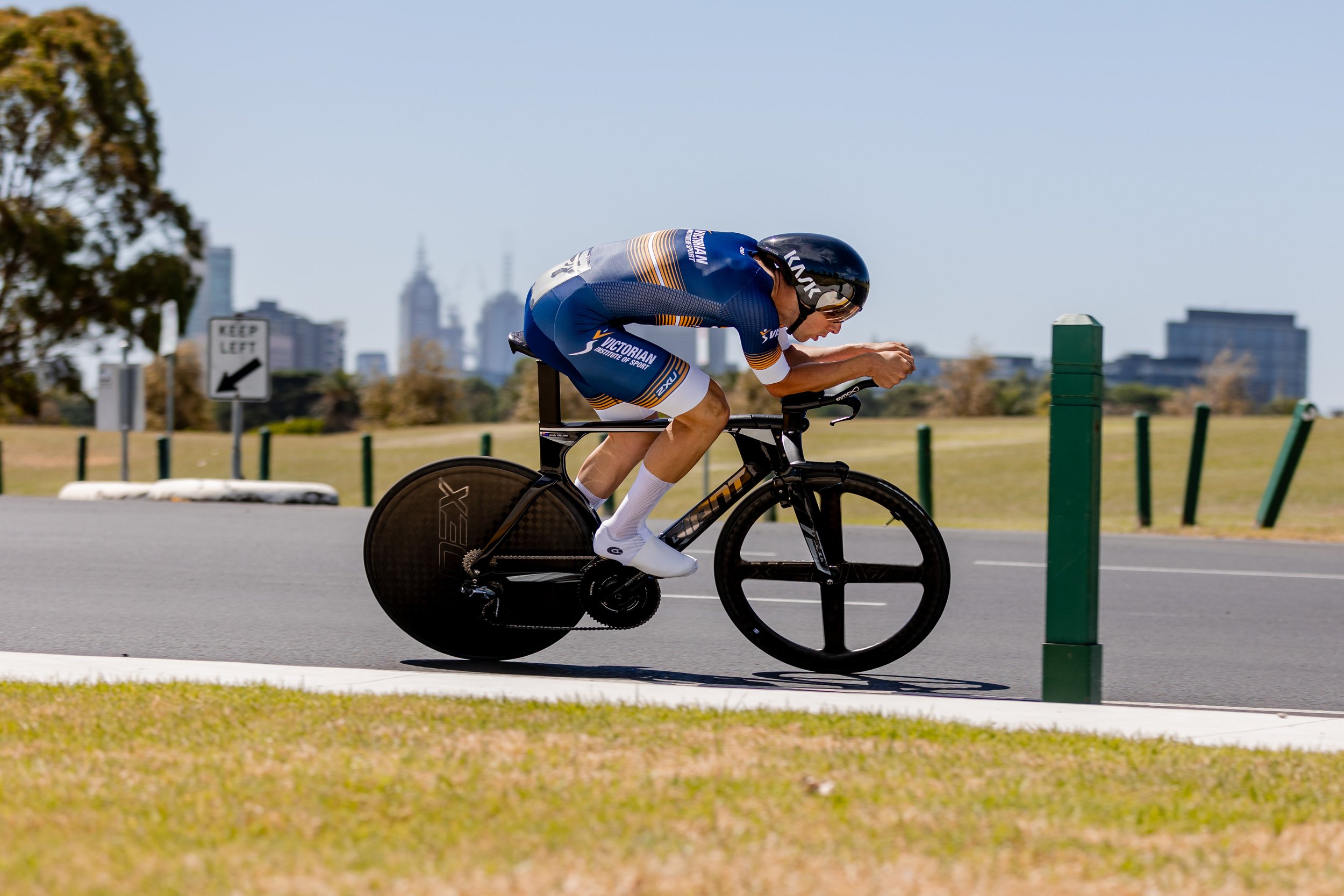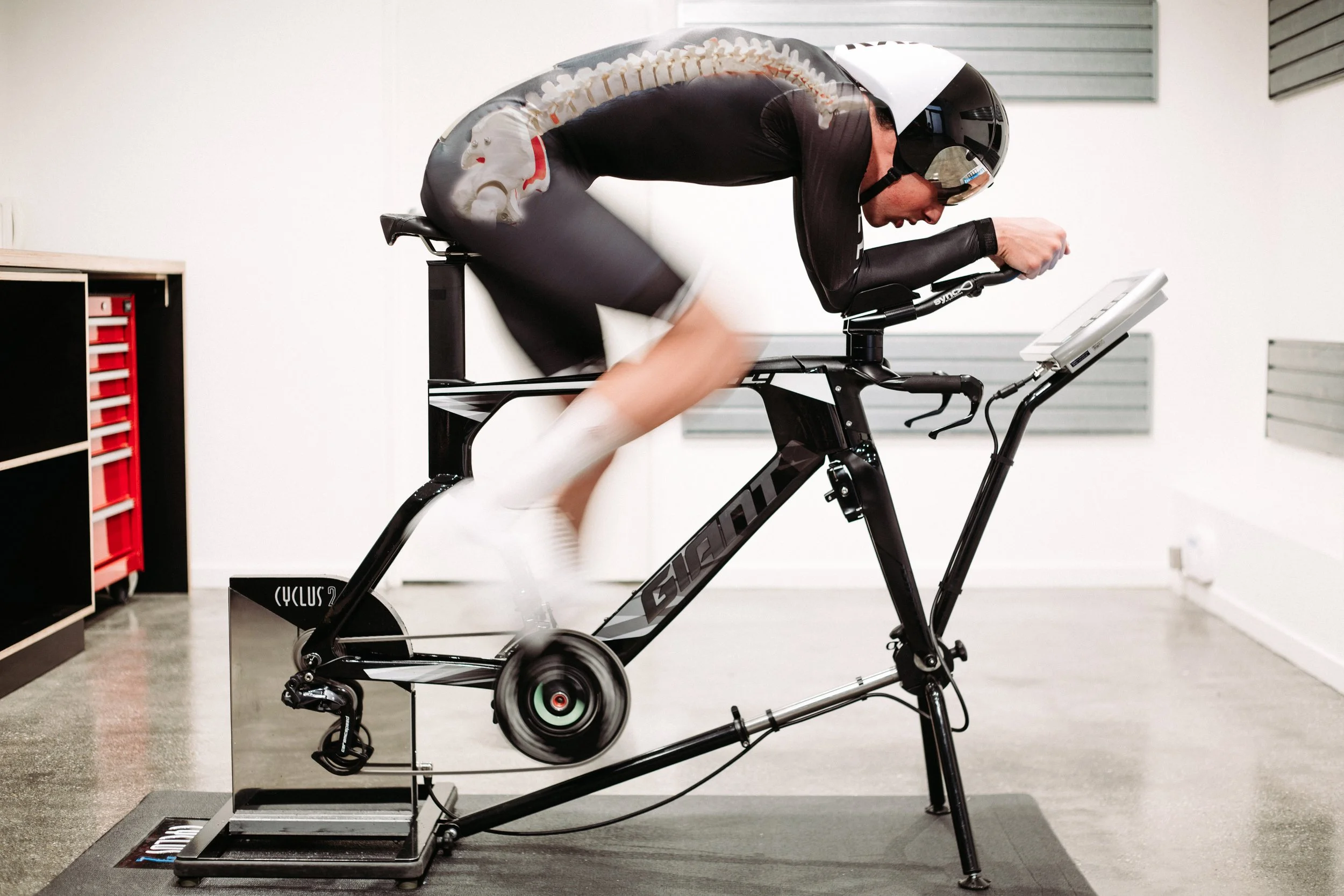Without a doubt, aerodynamics has had a significant impact on cycling performance, permeating every aspect of the sport. Developing as a time trial specialist is no secret; it requires a considerable amount of time, as this discipline of cycling heavily relies on specific physiological qualities and highly sophisticated equipment that continually evolves, with innovative trends emerging each year to optimise the power-to-drag ratio (Watts/CdA). Featured is my time trial setup on the Giant Trinity Advanced Pro. Let’s dive in.
W H Y I C H O S E T H E G I A N T T R I N I T Y
Time trialling revolves around two key variables: high power output and a low CdA. Over the past twelve months, I have focused on fine-tuning this setup to maximise performance and enhance training where it matters most. The geometry and modifications that the Giant Trinity offers provide ease of adjustability, enabling the establishment and maintenance of a consistent position. Just like in Formula 1, the margin for error becomes so small that every component is approached with precision. Time trial performance is no different—let’s break down some of the components.
O P T I M I S I N G F R O N T A L A R E A
The latest installment from SYNC Ergonomics is the new Aerobar Three (Prototype), a custom-fit solution designed to optimise my position under UCI Category 2 regulations. It’s important to consider that when riding a bicycle at relevant race speeds, more than 90% of resistance to forward motion results from aerodynamic drag (CdA), with approximately 70% of this drag attributed to airflow over the athlete (Lukes et al., 2005).
The underlying mechanism involved is how effectively an athlete can manipulate their projected frontal area concerning the size and shape of their body or object. While it is well known that achieving high-hand positions provides the greatest gain in reducing frontal area, research suggests that minimizing projected frontal area and improving aerodynamic shape are the most effective strategies for reducing CdA (Crouch et al., 2017).
The adjustability of the front end is crucial for achieving a sustainable position, allowing the athlete to “shrug” and “tuck” while maintaining a healthy balance between torso, hip, shoulder, and elbow angles—something that varies significantly between time trial, triathlon, and track pursuit.
S A D D L E C H O I C E: T H E C O N A C T P O I N T
A trademark of any effective time trial position is a low torso angle, achieved through anterior pelvic tilt on the saddle rather than spinal flexion. Minimising this flexion is crucial for preserving the long-term health of the lumbar and thoracic regions.
The Dash Stage (Standard) directly addresses this by supporting anterior pelvic tilt. Maintaining comfort in this position is essential for sustaining power over prolonged efforts without compromising aerodynamics.
Saddle choice and crank length complement each other and should be taken with a holistic approach, properly matching crank length to saddle height (leg length) is essential for achieving an optimal time trial position. When knee and hip pathology are in the equation, in conjunction with joint angle kinematics, crank length is critical from both a health and performance standpoint.
D R I V E L I N E & G E A R I N G C H O I C E S
Drivetrain efficiency has been a prominent topic over the past 12 months, with larger chainrings becoming the new norm. The concept behind going 1x revolves around chain line efficiency. For every four-tooth increase in the front chainring equates to moving up one cog in the cassette; for example, 58/15 and 62/16 offer approximately the same gear ratio.
Larger chainrings promote a smoother chain angle and reduce friction, allowing the chain to sit more centrally within the cassette rather than at the upper or lower extremes. From a real-world perspective, I have found that this setup results in a noticeably smoother cadence.
Currently installed is an array of components from SYNC Ergonomics x CSIXX Components,
SYNC x CSIXX 1x64t Chainring
SYNC x CSIXX Chain Guide
SYNC x CSIXX Pulley Wheels 12/14t
Power2Max NG 4-bolt, 110bcd Power Meter
Rotor ALDHU 170mm Cranks
YBN SLA 1210 Treated Waxed Chain.
Ceramic bearings across the build
Most of my training and competition is on flat terrain; I will switch between 62 and 64t (currently installed) chainrings and match them accordingly to the terrain. My gear choice selection was based on previous experience from track racing, utilising gear ratio charts – keeping it specific to physiological needs.
W H E E L S & R O L L I N G R E S I S T A N CE
To finish it all off, wheels add some nice bling to any TT bike. Producing wheel systems is a thorough process, balancing rolling resistance, aerodynamic shape, hub design/bearings, tyre-rim interaction, and tyre deformation are just some of the considerations that go into manufacturing high-performance wheels – something CADEX has excelled in delivering a well-balanced wheel. My 2025 setup includes:
CADEX Aero 4-Spoke Tubeless/Clincher front
CADEX Aero Disc Tubeless/Clincher rear
View-Speed Series 3 Aero Skewers
Continental GP5000 TT TR 700x25mm is my choice for tyres, being one of the very few brands that have the lowest rolling resistance and optimal aero profile/shape due to the tread pattern. Set up tubeless ready.
T E S T I N G M E A S U R E S
Achieving a low CdA without compromising power output requires consistent, objective testing. I have been fortunate to utilise indoor track aero testing through the Alphamantis Track Aero System and Notio systems, in collaboration with SYNC Ergonomics, to help quantify real-world outcomes of position optimisation, allowing for qualitative feedback. To date, I have completed over 100 test runs, covering more than 1,200 laps (300 kilometres).
These tools provide precise feedback on drag and power, enabling me to refine my setup effectively and address weaknesses in my position or performance on the bike. While wind tunnel testing remains the gold standard, indoor testing offers a practical and efficient alternative to assess aerodynamic drag as a complete package and refine as neccessary.
W H A T I S N E X T ?
Every element of my 2025 setup on the Giant Trinity Advanced Pro is selected to attain the balance between power output and aerodynamic efficiency. Research and testing have demonstrated the importance of integrating positional adjustments with equipment selection. As the season progresses, it’s all down to trusting the training and preparation, ensuring that when it matters most, rider and bike work in sync.
Stay tuned for more updates throughout the season.
A B O U T - A D A P T I V E H P
JORDAN VILLANI
Sports Scientist & Bike Fitter
B. Exercise & Sports Science, Elite Road Cyclist
Jordan combines a competitive edge with a scientific approach at AHP. A former VIS athlete and national team pursuit champion, he specializes in time trialing, endurance, and performance refinement. Years of racing and coaching have shaped his deep understanding of cycling biomechanics and demands. At AHP, Jordan blends technical expertise with his passion for cycling, offering an analytical, hands-on approach to bike fitting aimed at optimizing comfort and performance. His goal is to help cyclists unlock their potential with practical, results-driven solutions.
ERIN MACDONALD
Exercise Physiologist & Bike Fitter
B. Exercise & Sports Science,
M. Exercise Physiology, ASCA Level 1 Coach
Erin Macdonald is an experienced Exercise Physiologist with a passion for cycling and performance optimization. She has worked with top-tier teams like Bora Hansgrohe, Arkea Samsic, and the French National Cycling Team, excelling in endurance training, injury prevention, and performance optimization. For Erin, AHP is a platform to share her expertise and help cyclists achieve their best, combining her professional experience with a genuine desire to enhance every rider’s journey.
C R E D I T S
Images by: @stefhansonproductions & @brett_focusphotography
Special thank you to Giant Bicycles Australia, Cadex Australia, SYNC Ergonomics, CSIXX Components, Alphamantis Technologies, and STT Systems - 3D Motion Capture technology
R E F E R E N C E S
Lukes, R. A., Chin, S. B., & Haake, S. J. (2005). The understanding and development of cycling aerodynamics. Sports Engineering, 8(2), 59-74.
Crouch, T. N., Burton, D., & LaBry, Z. (2017). Understanding the aerodynamics of elite cyclists through wind tunnel testing. Journal of Sports Science, 35(10), 965-972.
























